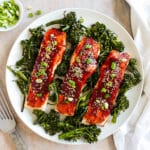Gochujang Salmon Recipe
If you've got 20 minutes, this gochujang salmon recipe is going to knock your socks off with bold flavor. The spicy-sweet-savory glaze is quick & easy, despite this being an elegant and impressive dish. Serve it with rice or noodles for a healthy & satisfying weeknight meal.
Servings: 4 servings
Calories: 228kcal
Ingredients
- 3 Tablespoons gochujang (Korean chili paste)
- 1 teaspoon fresh ginger, grated
- 1 teaspoon garlic powder
- 2 teaspoons low-sodium soy sauce
- 1 Tablespoon honey or maple syrup
- 1 Tablespoon rice wine vinegar
- 1 Tablespoon sesame oil
- ½ teaspoon salt
- ¼ teaspoon black pepper
- 1 pound salmon fillets (4 ounces each)
- ¼ cup scallions, thinly sliced (garnish)
- 2 Tablespoons toasted sesame seeds (optional garnish)
Instructions
- Preheat broiler and place the oven rack 6-8 inches away from broiler.
- Pat salmon dry using a paper towel. Line a baking sheet with foil and transfer salmon (skin side down) to prepared baking sheet.
- In a small bowl, whisk together the gochujang paste, fresh ginger, garlic powder, soy sauce, honey, rice wine vinegar, sesame oil, salt, and pepper.
- Use a pastry brush or the back of a spoon to glaze salmon with gochujang sauce.
- Broil salmon for 5-7 minutes, rotating pan halfway through. Keep an eye on it. If it starts to burn or smoke, move it to a lower rack.
- Let salmon rest for 5 minutes before serving. Garnish with scallions and sesame seeds. Serve with rice, noodles, or your favorite vegetable.
Notes
-
- Storage: Place in an airtight container and store in the fridge for up to 4 days.
-
- How to freeze: After completely cooled, transfer salmon to a freezer-safe container and freeze for up to 3 months. To thaw, place in refrigerator overnight.
-
- How to reheat: Cover loosely with foil and place salmon in a preheated 300 degree F. oven for 15 minutes, or until heated through.
-
- Don't overbake (if baking in oven). Salmon thickness varies, but aim for 4 to 6 minutes per half-inch of thickness. You could also use an instant-read thermometer to check for doneness. The USDA recommends a minimum internal temperature of 145 degrees F. at the thickest part of the fillet.
-
- Use low-sodium soy sauce. This is an easy way to control your sodium intake. If you only have regular soy sauce on hand, skip the additional salt.
-
- Salmon skin on or off. This is totally up to you, but leaving the skin on will add flavor to your salmon and help to prevent it from drying out when cooked.
Nutrition
Calories: 228kcal | Carbohydrates: 9g | Protein: 23g | Fat: 11g | Saturated Fat: 2g | Polyunsaturated Fat: 4g | Monounsaturated Fat: 4g | Cholesterol: 62mg | Sodium: 435mg | Potassium: 642mg | Fiber: 0.4g | Sugar: 6g | Vitamin A: 132IU | Vitamin C: 3mg | Calcium: 23mg | Iron: 1mg
